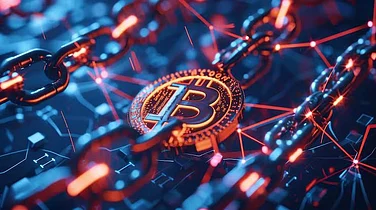In today's rapidly changing digital economy, blockchain technology is the cornerstone of financial innovation. Its decentralized and open nature not only transformed the way we think about digital assets but has also spawned DeFi Lending—a revolution in lending and borrowing without intermediaries.
Blockchain transactions are at the heart of this movement, ensuring trust, security, and automation in financial operations that once required banks, credit agencies, or regulatory authorities. In this article, we’ll explore how blockchain transactions work, their role in DeFi Lending, and why this ecosystem is reshaping global finance.
What Are Blockchain Transactions?
Essentially, a blockchain transaction is a digital trade of value or information on a ledger that is decentralized. Every transaction on the blockchain is confirmed by a membership network (nodes) via agreement mechanisms such as Proof of Work (PoW) or Proof of Stake (PoS).
The following explains why blockchain transactions are unique:
Immutable: After verification, a transaction cannot be altered or deleted.
Transparent: Transactions on public blockchains can be verified and tracked by anyone.
Secure: Transactions are encrypted and shared, so data tampering is nearly impossible.
Decentralized: No one authority controls it; code and consensus enshrine trust.
These attributes make blockchain transactions integrity and security-critical pillars of DeFi Lending platforms.
How Do Blockchain Transactions Work?
To keep pace, let's walk step by step:
Transaction Creation:
A user creates a transaction (for example, lending tokens to another user via a DeFi platform).
Broadcasting to the Network
The transaction is broadcast to the blockchain network to be verified.
Validation:
Miners or validators verify the correctness of the transaction through consensus algorithms.
Block Formation:
Once verified, the transaction is encased with others in a "block."
Block Addition:
This new block is appended to the current chain, forming an irreversible record of the transaction.
Completion:
The transaction is finalized and open on the blockchain to both parties.
This decentralized system makes each DeFi Lending transaction—borrowing, lending, or earning interest—secure, verifiable, and transparent.
DeFi Lending: A New Era of Borrowing and Lending
DeFi (Decentralized Finance) replaces traditional middlemen in the guise of banks and financial institutions with blockchain-based smart contracts. DeFi Lending allows one to lend their digital assets to another and collect interest, or borrow against their assets as collateral—all through self-executing, trustless systems.
All because of the blockchains' transactions that make the process automated and untainted by human error or manipulation.
The Application of Smart Contracts in Blockchain Transactions
Smart contracts are self-executing code that automates agreements upon certain conditions being fulfilled.
In DeFi Lending, smart contracts manage:
Loan approval and payment
Collateral management
Interest calculation and repayment
Liquidation in default
For example, if a user collateralizes with cryptocurrency, the smart contract automatically disburses a loan in stablecoins. If the value of the collateral drops below a certain threshold, the contract automatically triggers liquidation—no human intervention necessary.Each of these actions depends on blockchain transactions to store securely and transparently each step.
How Blockchain Transactions Support DeFi Lending
Blockchain transactions provide four essential benefits that enable DeFi Lending and scalability:
Transparency and Auditability
Every transaction is posted on an open book, enabling users to track the flow of money in real time. This enables participants to trust one another.
Security and Immutability
Cryptographic verification makes sure that, once a loan transaction has been made, it cannot be rewritten or undone. It secures users from interference.
Automation With Smart Contracts
Blockchain transactions go through automatically according to programmed conditions without requiring intermediaries.
Global Access and Financial Inclusion
Anyone who has an internet connection and crypto wallet can use DeFi Lending, no matter the country of origin, income level, or having a bank account.
Risks and Challenges with Blockchain Transactions and DeFi Lending
Where the pay is incredible, challenges lurk as well:
Volatility: The worth of collateral can change dramatically, leading to liquidation.
Smart Contract Bugs: Coding errors can be taken advantage of by hackers for their gain.
Regulatory Uncertainty: DeFi sites exist in a legal gray area.
Scalability Problems: Excessive transaction fees or network congestion can retard transactions.
Despite these problems, ongoing advancements in blockchain scalability. (e.g., Layer 2 solutions) and smarter smart contract audits are strengthening and securing DeFi Lending.
Future of Blockchain Transactions and DeFi Lending
The convergence of blockchain with artificial intelligence (AI), Internet of Things (IoT), and digital identity solutions will further enrich DeFi Lending. We are heading towards an autonomous world of financial systems without borders or central authority.
In the near term:
Cross-chain lending will go mainstream enabling easy movement of assets from one blockchain to another.
Real-world assets (e.g., real estate or commodities) will be tokenized for decentralized lending.
Regulatory systems will have shifted, making investors more inclined to engage with DeFi.
Blockchain transactions will remain the behind-the-scenes force driving this decentralized economy.
FAQs on Blockchain Transactions and DeFi Lending
Q1. What is DeFi Lending explained simply?
A: DeFi Lending is a system where individuals can lend and borrow digital assets directly, without middlemen or banks, using smart contracts on blockchain to automate and secure the process.
Q2. How are transactions authenticated in blockchain?
A: Transactions are validated through network members (validators or miners) with consensus mechanisms such as Proof of Stake or Proof of Work, thus making it authentic and double-spending resistant.
Q3. Is DeFi Lending secure?
A: Although blockchain transactions are secure, there are risks via market volatility and possible smart contract exposures. Vigilant platforms and exposures to collateral awareness are necessary.
Q4. How are smart contracts employed in DeFi Lending?
A: Smart contracts make all lending transactions—from loan approvals to releasing of collateral—both human-free and interaction-free with absolute transparency.
Q5. Can anyone use DeFi Lending?
A: Anybody with access to the internet and a crypto wallet can lend or borrow on DeFi platforms, and hence it is global inclusive and borderless.
Conclusion
Blockchain transactions have reconfigured the way that financial systems operate—securely, publicly, and independently. DeFi Lending avoids middlemen, making customers in control of their money while earning passive income or immediate liquidity.
While technology continues to develop, blockchain will keep on reshaping world finance, and DeFi Lending will also still remain one of its most exciting innovations—narrowing the gap between technology, trust, and economic liberty.





















